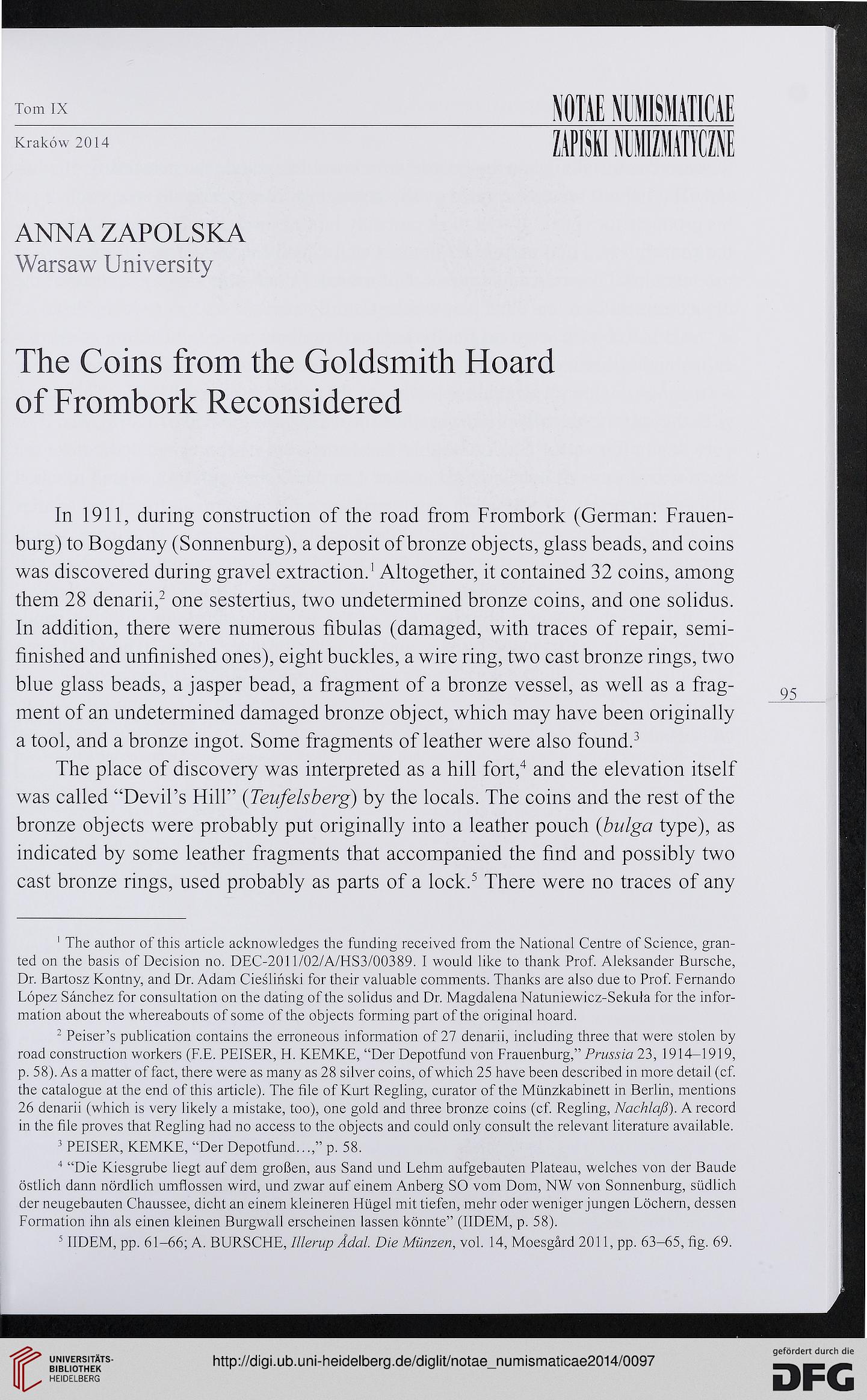Tom IX
Kraków 2014
ANNA ZAPOLSKA
Warsaw University
The Coins &om the Goldsmith Hoard
of Frombork Reconsidered
In 1911, during construction of the road from Frombork (German: Frauen-
burg) to Bogdany (Sonnenburg), a deposit of bronze objects, glass beads, and coins
was discovered during gravel extraction.' Altogether, it contained 32 coins, among
them 28 denarii,- one sestertius, two undetermined bronze coins, and one solidus.
In addition, there were numerous hbulas (damaged, with traces of repair, semi-
hnished and unhnished ones), eight buckles, a wire ring, two cast bronze rings, two
blue glass beads, a jasper bead, a fragment of a bronze vessel, as well as a frag-
ment of an undetermined damaged bronze object, which may have been originally
a tool, and a bronze ingot. Some fragments of leather were also found. '
The place of discovery was interpreted as a hill fort,"* and the e!evation itself
was called "DeviFs Hill" by the locals. The coins and the rest of the
bronze objects were probably put originally into a leather pouch type), as
indicated by some leather fragments that accompanied the frnd and possibly two
cast bronze rings, used probably as parts of a lock2 There were no traces of any
' The author of this article acknowledges the funding received from the National Centre of Science, gran-
ted on the basis of Decision no. DEC-2011/02/A/HS3/00389. I would like to thank Prof. Aleksander Bursche,
Dr. Bartosz Kontny, and Dr. Adam Cieśliński for their valuable comments. Thanks are also due to Prof. Fernando
López Sanchez for consultation on the dating of the solidus and Dr. Magdalena Natuniewicz-Sekuła for the infor-
mation about the whereabouts of some of the objects forming part of the original hoard.
- Peiser's publication contains the erroneous information of 27 denarii, including three that were stolen by
road construction workers (F.E. PEISER, H. KEMKE, "Der Depotfund von FrauenburgTPrM^/o 23, 19)4-1919,
p. 58). As a matter of fact, there were as many as 28 silver coins, of which 25 have been described in morę detail (cf.
the catalogue at the end of this article). The file of Kurt Regling, curator of the Munzkabinett in Berlin, mentions
26 denarii (which is very likely a mistake, too), one gotd and three bronze coins (cf. Regling, ACfcA/o/?). A record
in the file proves that Regling had no access to the objects and could only consult the re)evant literaturę avaitable.
^ PEISER, KEMKE, "Der Depotfund...," p. 58.
" "Die Kiesgrube liegt auf dem groBen, aus Sand und Lehm aufgebauten Plateau, welches von der Baude
óstlich dann nórdtich umflossen wird, und zwar auf einem Anberg SO vom Dom, NW von Sonnenburg, stidlich
der neugebauten Chaussee, dicht an einem kteineren Hugel mit tiefen, mehr oder weniger jungen Lochem, dessen
Formation ihn ais einen kteinen Burgwatl erscheinen lassen kónnte" (UDEM, p. 58).
^ UDEM, pp. 61-66; A. BURSCHE, ///erHo D;'e Mrmzew, vol. 14, Moesgard 2011, pp. 63-65, Eg. 69.
95
Kraków 2014
ANNA ZAPOLSKA
Warsaw University
The Coins &om the Goldsmith Hoard
of Frombork Reconsidered
In 1911, during construction of the road from Frombork (German: Frauen-
burg) to Bogdany (Sonnenburg), a deposit of bronze objects, glass beads, and coins
was discovered during gravel extraction.' Altogether, it contained 32 coins, among
them 28 denarii,- one sestertius, two undetermined bronze coins, and one solidus.
In addition, there were numerous hbulas (damaged, with traces of repair, semi-
hnished and unhnished ones), eight buckles, a wire ring, two cast bronze rings, two
blue glass beads, a jasper bead, a fragment of a bronze vessel, as well as a frag-
ment of an undetermined damaged bronze object, which may have been originally
a tool, and a bronze ingot. Some fragments of leather were also found. '
The place of discovery was interpreted as a hill fort,"* and the e!evation itself
was called "DeviFs Hill" by the locals. The coins and the rest of the
bronze objects were probably put originally into a leather pouch type), as
indicated by some leather fragments that accompanied the frnd and possibly two
cast bronze rings, used probably as parts of a lock2 There were no traces of any
' The author of this article acknowledges the funding received from the National Centre of Science, gran-
ted on the basis of Decision no. DEC-2011/02/A/HS3/00389. I would like to thank Prof. Aleksander Bursche,
Dr. Bartosz Kontny, and Dr. Adam Cieśliński for their valuable comments. Thanks are also due to Prof. Fernando
López Sanchez for consultation on the dating of the solidus and Dr. Magdalena Natuniewicz-Sekuła for the infor-
mation about the whereabouts of some of the objects forming part of the original hoard.
- Peiser's publication contains the erroneous information of 27 denarii, including three that were stolen by
road construction workers (F.E. PEISER, H. KEMKE, "Der Depotfund von FrauenburgTPrM^/o 23, 19)4-1919,
p. 58). As a matter of fact, there were as many as 28 silver coins, of which 25 have been described in morę detail (cf.
the catalogue at the end of this article). The file of Kurt Regling, curator of the Munzkabinett in Berlin, mentions
26 denarii (which is very likely a mistake, too), one gotd and three bronze coins (cf. Regling, ACfcA/o/?). A record
in the file proves that Regling had no access to the objects and could only consult the re)evant literaturę avaitable.
^ PEISER, KEMKE, "Der Depotfund...," p. 58.
" "Die Kiesgrube liegt auf dem groBen, aus Sand und Lehm aufgebauten Plateau, welches von der Baude
óstlich dann nórdtich umflossen wird, und zwar auf einem Anberg SO vom Dom, NW von Sonnenburg, stidlich
der neugebauten Chaussee, dicht an einem kteineren Hugel mit tiefen, mehr oder weniger jungen Lochem, dessen
Formation ihn ais einen kteinen Burgwatl erscheinen lassen kónnte" (UDEM, p. 58).
^ UDEM, pp. 61-66; A. BURSCHE, ///erHo D;'e Mrmzew, vol. 14, Moesgard 2011, pp. 63-65, Eg. 69.
95




